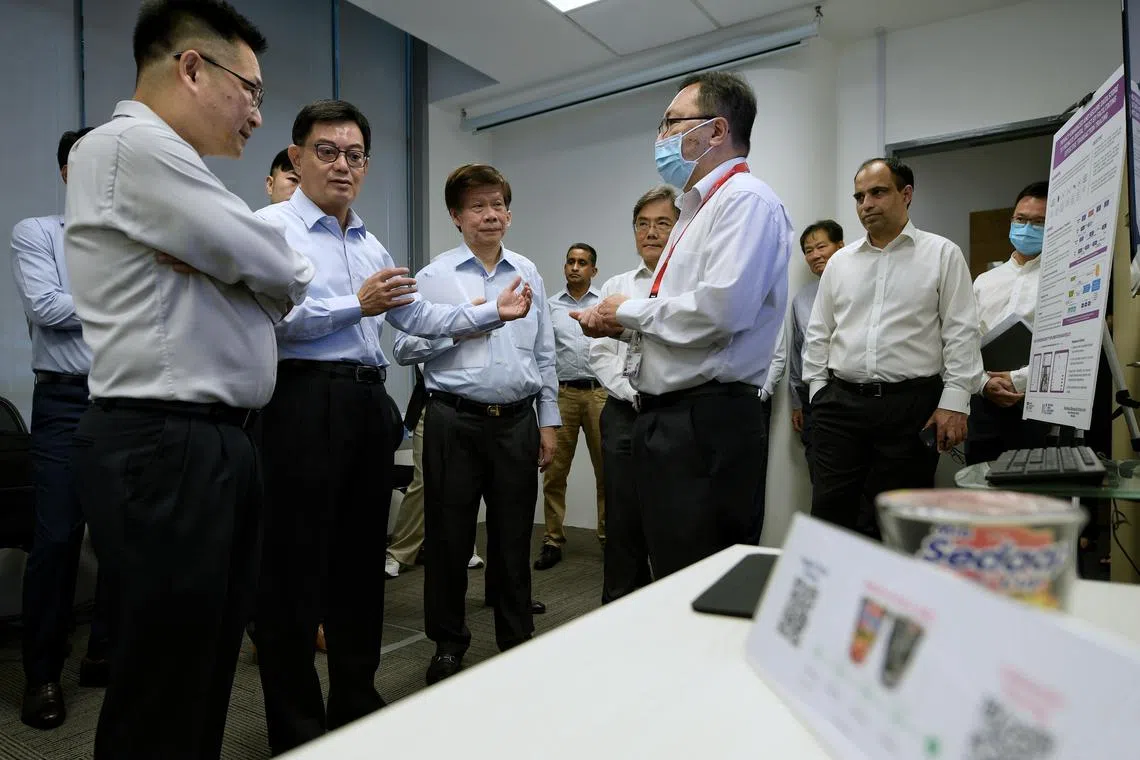OCBC and NTU announce $5 million research collaboration to chase ‘holy grail’ of encryption tech
Sign up now: Get ST's newsletters delivered to your inbox

DPM Heng Swee Keat on a tour of NTU's Strategic Centre for Research in Privacy-Preserving Technologies & Systems, on Nov 10, 2022.
ST PHOTO: NG SOR LUAN
Follow topic:
SINGAPORE - Companies typically keep customer data out of public servers for fear of sensitive information landing in the wrong hands.
But firms like OCBC Bank are counting on a method of coding – called homomorphic encryption (HE) – as a means to share data with partners and artificial intelligence (AI) apps, while keeping sensitive information hidden, even on a public server.
Widely held as the “holy grail” of privacy, HE guarantees privacy by allowing computation or AI analysis to be performed on encrypted data without the need for decryption, keeping the final result in encrypted form.
Only data owners – like a hospital or a bank – who possess the key can decrypt the final results.
HE is unlike traditional data processing, which needs to run on decrypted data before it can be analysed, leaving the sensitive data open to being stolen by hackers or insiders who have repeated access to it.
On Thursday, OCBC announced a $5 million collaboration with Nanyang Technological University (NTU) to research the technology over the next five years, which could allow it to bolster the bank’s analytics arsenal while protecting its customers’ data.
HE technology enables data to be handled between multiple organisations or AI software while ensuring sensitive data is kept hidden, said Professor Lam Kwok Yan, the director of NTU’s Strategic Centre for Research in Privacy-Preserving Technologies and Systems (Scripts), which specialises in privacy-preserving technologies.
The technology has attracted tech firms including Meta, prompting the social media giant to go on a hiring spree last year to nab key HE research specialists. The technology is also being trialled in the medical industry as it deals with sensitive patient data, which can potentially be shared with researchers for analysis without the risk of compromising patients’ privacy. The HE market is expected to roughly double to $420 million by 2030.
Banks can use HE to safely authenticate customers’ voice, fingerprints or other biometric data that it receives from e-commerce sites during payment, for instance, said Prof Lam. This ensures that the customer’s biometric data is not accessible to third-party sites and left open to being leaked.
Multiple organisations can also work together using HE to analyse trends in financial crimes using large data sets without disclosing the sensitive information that may be contained within it, he added.
“With cross-industry and jurisdictional boundaries becoming increasingly blurred, risk management enforcements and controls are now more complex and challenging to establish and enforce,” said Prof Lam.
“The organisations usually don’t want to exchange financial data, but with HE, they can detect patterns of financial crimes without disclosing the sensitive information.”
He told The Straits Times: “A lot of data is captured today through the growth of digitalisation. One of the major hurdles is that people worry about their personal privacy, so now, we can address this, removing one hurdle in the path to digital transformation.”
The five-year project, which was launched today at NTU with Deputy Prime Minister Heng Swee Keat in attendance, will also study technological solutions in cyber security and sustainability.

The five-year project will also study technological solutions in cybersecurity and sustainability.
PHOTO: OCBC
Prof Lam said one of the projects in the pipeline is the use of AI to analyse and summarise threat reports from global networks. Such reports are often in the thousands and impossible for analysts to read through manually, he added.
There is an increasing need for cyber-security measures, as a 2021 study found that the financial services sector was the most targeted in Singapore, said Prof Lam.
NTU will also study how AI can help to cut emissions at OCBC Bank’s data centres, which account for 40 per cent of the bank’s local carbon emissions. For example, AI can take over manual monitoring to automatically regulate the temperature in its data halls, said OCBC in a statement.
OCBC head of group operations and technology Praveen Raina said: “Financial institutions can offer industry knowledge and use cases that research institutions can draw on to conduct analysis and studies to assess the real-world applicability of research.
“Through this partnership, I am looking forward to new solutions and capabilities that we can use to augment our digital infrastructure and continuously strengthen customers’ trust in us.”

